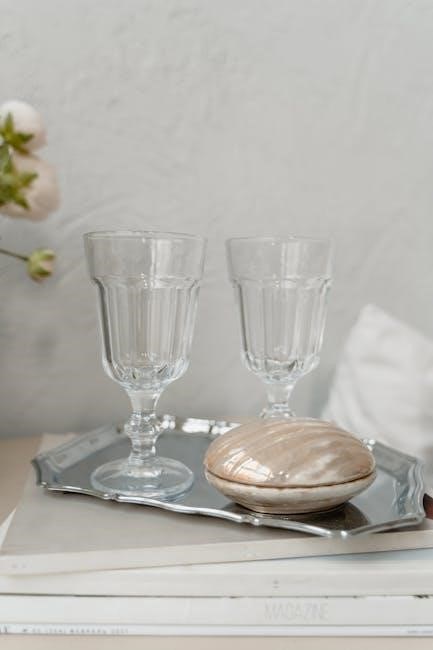The VITA Classical Shade Guide is a global standard in dentistry, offering 16 natural tooth shades (A1-D4) for precise color matching. Widely used since 1956, it ensures consistent communication in dental terminology, making it an essential tool for dentists worldwide.
1.1 Overview of the VITA Classical Shade Guide
The VITA Classical Shade Guide is a widely recognized dental tool featuring 16 natural tooth shades (A1-D4), organized into four color groups: A (reddish-brown), B (reddish-yellow), C (grayish), and D (reddish-gray). This system provides a standardized method for tooth color matching, ensuring consistent communication between dentists and laboratories. Its simple, value-oriented arrangement, from lightest to darkest, facilitates efficient shade selection, making it a cornerstone in modern dentistry for over 50 years.
1.2 Importance in Dental Terminology
The VITA Classical Shade Guide has become an integral part of international dental terminology, providing a universal language for tooth color communication. Its standardized shades (A1-D4) ensure consistency in prescriptions and laboratory workflows, reducing misunderstandings. This system’s global adoption has cemented its role as a fundamental reference point in dentistry, facilitating precise and reliable color matching for restorative treatments and prosthetics. Its widespread use underscores its significance in maintaining uniformity across dental practices worldwide.
History and Evolution of the VITA Classical Shade Guide
Introduced in 1956, the VITA Classical Shade Guide revolutionized dental color matching with its 16 natural shades. Over 50 years, it has remained a global standard, evolving to meet modern dental needs while maintaining its core simplicity and effectiveness in tooth shade determination.
The VITA Classical Shade Guide was first introduced in 1956 by VITA Zahnfabrik, revolutionizing dental color matching. It standardized tooth shade communication with 16 natural shades (A1-D4), simplifying the process for dentists. This innovation replaced complex systems, offering a user-friendly solution. Its development marked a significant milestone in dental prosthetics, providing a reliable tool for accurate shade selection; The guide quickly gained international acceptance, becoming a cornerstone in dental aesthetics and terminology.
2.2 50 Years of Global Use in Dentistry
For over 50 years, the VITA Classical Shade Guide has been a trusted global standard in dentistry. Its universal acceptance stems from its simplicity and reliability in tooth shade selection. Originally introduced in 1956, it has evolved to meet modern demands, including autoclavable materials and wider tabs for secure retention. Today, it remains a cornerstone for dentists worldwide, ensuring consistent communication and precise color matching in dental aesthetics and prosthetics.

Core Features of the VITA Classical Shade Guide
The VITA Classical Shade Guide features 16 natural tooth shades, high-quality ceramic tabs, and a simple, effective system for precise color matching, ensuring accurate results.
3.1 16 Natural Tooth Shades (A1-D4)
The VITA Classical Shade Guide includes 16 natural tooth shades, categorized into four groups: A (reddish-brown), B (reddish-yellow), C (grayish), and D (reddish-gray). These shades range from light to dark, providing a comprehensive spectrum for accurate matching. Each shade is empirically derived, ensuring natural aesthetics and consistency. This system has become the international standard for tooth color communication in dentistry, facilitating precise and reliable shade selection for restorations and treatments.
3.2 High-Quality VITA Ceramic Shade Tabs
The VITA Classical Shade Guide features high-quality ceramic shade tabs, renowned for their durability and precise color representation. Made from VITA ceramic, these tabs ensure long-lasting color accuracy and resistance to wear. Their natural aesthetics and consistent quality make them indispensable for reliable shade matching. The ceramic material closely mimics natural tooth enamel, providing dentists with a trusted tool for achieving accurate and visually appealing results in dental restorations.
3.4 Simple and Effective Shade Matching
The VITA Classical Shade Guide offers a straightforward method for shade matching, enabling dentists to quickly compare tabs with natural teeth. Its intuitive design allows for one-step determination, ensuring efficiency and accuracy. The guide’s logical arrangement simplifies the process, making it accessible even for less experienced professionals. This simplicity enhances patient communication and streamlines treatment planning, ultimately contributing to consistent and satisfactory aesthetic outcomes in dental procedures.
Arrangement and Classification of Shades
The VITA Classical Shade Guide is organized by value, with shades arranged from light to dark. It categorizes shades into four groups (A, B, C, D), ensuring systematic matching.
4.1 Value-Oriented Shade Guide Arrangement
The VITA Classical Shade Guide is arranged by value, starting with B1 (lightest) and progressing through A1, B2, D2, A2, C1, C2, D4, A3, D3, B3, A3.5, B4, C3, A4, and C4 (darkest). This value-oriented system allows for efficient shade matching, enabling dentists to quickly identify the closest shade to natural teeth. The structured arrangement simplifies the selection process, ensuring accurate and consistent results in dental procedures.
4.2 Shade Families: A, B, C, and D Groups
The VITA Classical Shade Guide organizes shades into four distinct families: A, B, C, and D. Group A represents reddish-brown shades, B features reddish-yellow tones, C includes grayish shades, and D combines reddish-gray hues. This classification system provides a structured approach to tooth color matching, enabling dentists to categorize and communicate shades effectively. Each group offers a range of options, ensuring precise alignment with natural tooth colors for aesthetic and restorative dental procedures.
4.3 Detailed Shade Progression (B1, A1, B2, D2, etc.)
The VITA Classical Shade Guide follows a specific progression, starting with B1 as the lightest shade, followed by A1, B2, D2, A2, C1, C2, D4, A3, D3, B3, A3.5, B4, C3, A4, and C4. This sequence ensures a logical transition from lighter to darker shades, allowing for precise tooth shade determination. The progression is designed to simplify shade matching, enabling dentists to communicate effectively and consistently with laboratories and patients.
VITA Bleached Shades: An Additional Tool
The VITA Bleached Shades (0M1, 0M2, 0M3) complement the Classical Shade Guide, offering shades for teeth whitening. They enhance the guide’s versatility, aiding in precise color matching for bleached teeth.
5.1 Integration with the Classical Shade Guide
The VITA Bleached Shades seamlessly integrate with the Classical Shade Guide, expanding its applications. These shades (0M1, 0M2, 0M3) are derived from the VITA 3D-Master system and are designed to complement the existing A1-D4 range. They allow dentists to address tooth whitening cases effectively while maintaining consistency with the familiar Classical Shade Guide system.
This integration ensures a smooth transition between natural and bleached tooth shade selections, enhancing clinical efficiency and patient satisfaction.
5.2 Shades for Teeth Whitening (0M1, 0M2, 0M3)
The VITA Bleached Shades (0M1, 0M2, 0M3) are specifically designed for teeth whitening cases. Originating from the VITA 3D-Master system, these shades are integrated into the Classical Shade Guide, providing a practical tool for monitoring whitening progress. They allow patients and dentists to discuss and achieve desired aesthetic outcomes effectively. This integration ensures a comprehensive approach to tooth color determination, enhancing both clinical efficiency and patient satisfaction.

Manufacturing Quality and Materials
The VITA Classical Shade Guide features high-quality ceramic shade tabs and a durable, autoclavable holder. Its robust design ensures long-term reliability and precise color consistency in dental applications.
6.1 Autoclavable Holder and Tabs
The VITA Classical Shade Guide features an autoclavable holder, ensuring sterility and durability. The high-quality ceramic tabs are designed to withstand repeated autoclaving without fading or damage, maintaining precise color accuracy. This feature enhances hygiene and longevity, making it a reliable tool for dental professionals. The robust construction supports frequent use in clinical settings, ensuring consistent performance over time.
6.2 Wider Metal Tabs for Secure Retention
The VITA Classical Shade Guide incorporates wider metal tabs for secure retention in the holder. This design prevents tabs from loosening or falling out during use, ensuring stability and ease of handling. The improved retention system enhances the guide’s durability, making it a practical choice for daily clinical applications. This feature, combined with high-quality materials, contributes to the guide’s long lifespan and reliable performance in dental settings.

Clinical Applications and Usage
The VITA Classical Shade Guide is essential for tooth shade determination, enabling quick and accurate matching. It aids in patient communication and treatment monitoring, ensuring consistent results.
7.1 Tooth Shade Determination in One Step
The VITA Classical Shade Guide simplifies tooth shade selection by allowing dentists to determine the shade in a single step. The guide’s high-quality ceramic tabs are arranged in a logical sequence, making it easy to compare and match shades directly with the patient’s teeth. This streamlined process enhances efficiency and accuracy in clinical settings, ensuring consistent and reliable results for dental restorations and aesthetic procedures.
7.2 Patient Communication and Treatment Monitoring
The VITA Classical Shade Guide enhances patient communication by providing a visual tool to explain treatment options and desired outcomes. Dentists can use the shade tabs to demonstrate color choices, ensuring patients understand the aesthetic goals. Additionally, the guide aids in monitoring tooth whitening progress, allowing patients to see the results of their treatment and discuss further adjustments, fostering collaboration and satisfaction throughout the dental process.
Comparison with Other Shade Guide Systems
The VITA Classical Shade Guide stands out for its simplicity and 16 natural shades, making it a widely accepted international standard compared to more complex systems like Chromascop.
8.1 VITA Classical vs. VITA 3D-Master
The VITA Classical Shade Guide offers 16 natural tooth shades (A1-D4), while the VITA 3D-Master provides 26 shades and 29 levels of lightness for greater complexity. The Classical guide is preferred for its simplicity and universal acceptance, whereas the 3D-Master is ideal for advanced aesthetic cases requiring precise color matching. Both systems are compatible with bleached shades, but the 3D-Master offers enhanced customization and accuracy for modern dental applications.
8.2 Differences from Chromascop and Trubyte Bioform
The VITA Classical Shade Guide differs from Chromascop and Trubyte Bioform in its simplicity and universal acceptance. While Chromascop focuses on hue, saturation, and value, and Trubyte Bioform emphasizes natural tooth variations, the VITA guide is renowned for its straightforward 16-shade system (A1-D4). Its global standardization makes it a preferred choice in dental terminology, unlike the more complex systems of its competitors, ensuring consistency across practices worldwide.
Maintenance and Care of the Shade Guide
Regular disinfection and autoclaving ensure longevity. Proper handling prevents wear, while secure storage maintains accuracy. Durable materials withstand repeated use, preserving the guide’s effectiveness in clinical settings.
9.1 Disinfection and Autoclaving
The VITA Classical Shade Guide is designed for easy disinfection and autoclaving, ensuring hygiene and durability. The autoclavable holder and ceramic tabs withstand high temperatures, maintaining accuracy. Regular disinfection prevents contamination, while autoclaving at 134°C for 15 minutes is recommended. Proper sterilization extends the guide’s lifespan, ensuring reliable shade matching in clinical settings. Always follow manufacturer guidelines to preserve the guide’s effectiveness and patient safety.
9.2 Handling and Storage Recommendations
Proper handling and storage are crucial for maintaining the VITA Classical Shade Guide’s accuracy. Clean the guide with mild soap and water, avoiding harsh chemicals. Store it in a dry, cool place away from direct sunlight. Use a protective case to prevent damage; Regular maintenance ensures the guide remains precise and durable, supporting its long-term use in dental practices. Always follow manufacturer guidelines for optimal performance and longevity.

Impact on Dental Prosthetics and Aesthetics
The VITA Classical Shade Guide enhances dental prosthetics by standardizing tooth color communication, ensuring natural aesthetics. Its precise shades enable consistent results, boosting patient satisfaction and clinical success.
10.1 Standardization in Dental Terminology
The VITA Classical Shade Guide has revolutionized dental terminology by standardizing tooth shade communication. Its universal system ensures consistency across global dental practices, enabling precise descriptions of tooth colors. This standardization facilitates effective communication between dentists, laboratories, and patients, reducing misunderstandings and enhancing treatment outcomes. The guide’s widespread adoption has cemented its role as a cornerstone in modern dental terminology, ensuring clarity and accuracy in shade matching and prosthetic procedures.
10.2 Role in Achieving Perfect Color Matching
The VITA Classical Shade Guide plays a pivotal role in achieving perfect color matching by providing a standardized and intuitive system. Its 16 natural shades allow for precise alignment with patient tooth colors, ensuring aesthetic and functional outcomes. The guide’s simplicity and effectiveness make it a trusted tool for dentists, enabling accurate shade selection and enhancing patient satisfaction in both restorative and cosmetic procedures.
The VITA Classical Shade Guide remains an iconic standard in dentistry, offering unparalleled color accuracy and standardization. Its enduring relevance promises continued innovation and excellence.
11.1 Summary of Key Features
The VITA Classical Shade Guide features 16 natural tooth shades (A1-D4), arranged for easy matching. It includes high-quality ceramic tabs and a value-oriented system, ensuring precise color determination. The guide is autoclavable, durable, and integrates with bleached shades for comprehensive use. Its simplicity and effectiveness have solidified its role as a global dental standard since 1956, providing reliable and consistent results in tooth shade matching.
11.2 Future Prospects and Innovations
The VITA Classical Shade Guide is poised for advancements, potentially integrating digital tools for enhanced precision. Future innovations may include expanded shade ranges to accommodate diverse patient needs and material improvements for durability. The guide’s timeless relevance ensures its continued evolution, aligning with modern dental practices while maintaining its core simplicity and effectiveness for accurate tooth shade matching and aesthetic outcomes.


